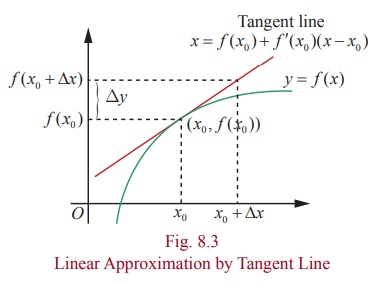Mathematics - Linear Approximation | 12th Maths : UNIT 8 : Differentials and Partial Derivatives
Chapter: 12th Maths : UNIT 8 : Differentials and Partial Derivatives
Linear Approximation
Linear
Approximation and Differentials
Linear
Approximation
In this
section, we introduce linear approximation of a function at a point. Using the
linear approximation, we shall estimate the function value near a chosen point.
Then we shall introduce differential of a real-valued function of one variable,
which is also useful in applications.
Let f : (a,
b) ŌåÆ ŌäØ be a differentiable function and x Ōłł(a,
b) . Since f is differentiable at x
, we have

where Ōēł
means ŌĆ£approximatelyŌĆØ
equal. Also, observe that as the independent variable changes from x to
x + xΔ, the function value changes from f ( x) to
f ( x + Δx) . Hence if Δx is small and the change in the output is denoted by Δf or Δy , then (2) can be rewritten as
change
in the output = ╬öy = ╬öf = f ( x + ╬öx) ŌłÆ f (x) Ōēł f ŌĆś(x) ╬öx.
Note
that (3) helps in approximating the value of f ( x + Δx) using f ( x) and
f ŌĆś ( x) ╬öx . Also, for a fixed
x0 , y( x ) =
f ( x0 ) + f
ŌĆ▓(
x0 )( x ŌłÆ x0 ), x Ōłł R, gives the tangent line for the graph of f at ( x0 , f ( x0 )) which gives a good approximation to the function f near x0 . This leads us to define
Definition 8.1 (Linear
Approximation)
Let f : (a,
b) ŌåÆ ŌäØ be a differentiable function and x0 Ōłł(a, b)
. We define the linear approximation L
of f at x0 by
L ( x) = f ( x0 ) + f ŌĆ▓( x0 )(
x ŌłÆ x0 ), ŌłĆx Ōłł (a, b) ... (4)
Note
that by (3) and (4) we see that
f ( x + ╬öx) Ōēł f (x) + f ŌĆ▓ (x) ╬öx
,
which is
useful in approximating the value of f ( x + Δx).
Note that linear approximation for f at x0 gives a good approximation to f ( x) if x is close to x0 , because
Tangent
line x = f (x0) + f ŌĆ▓(x0)(xŌłÆx0)

Error = f (x)
ŌłÆ
L ( x) = f
(x ) ŌłÆ f
(x0 ) ŌłÆ
f ŌĆ▓(x0
)(x ŌłÆ x0
) ... (5)
approaches
zero as x approaches to x0 by continuity of f at x0
. Also, if f ( x) = mx
+
c , then its linear approximation is L ( x)
=
(mx0 +
c ) + m(x ŌłÆ x0
) =
mx + c
=
f (x) , for any point x Ōłł(a,
b) . That is, the linear
approximation, in this case, is the original function itself (is it not
surprising?).
Example 8.1
Find the
linear approximation for f (x) = ŌłÜ(1+x)
, x Ōēź ŌłÆ1, at x0 = 3. Use the linear approximation to estimate f (3.2) .
Solution
We know
from (4), that L(x) = f (x0)
+ f ŌĆ▓(x0)(x ŌłÆ x0) . We have x0 = 3, ╬öx = 0.2 and hence f (3) = ŌłÜ(1+ 3) = 2 . Also,

Actually,
if we use a calculator to calculate we get ŌłÜ4.2 = 2.04939.
Related Topics